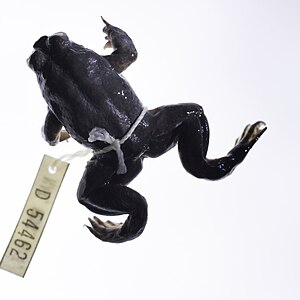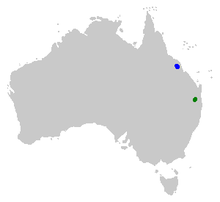Stomach breeder frogs
| Stomach breeder frogs | ||||||||||||
|---|---|---|---|---|---|---|---|---|---|---|---|---|

Rheobatrachus silus |
||||||||||||
| Systematics | ||||||||||||
|
||||||||||||
| Scientific name | ||||||||||||
| Rheobatrachus | ||||||||||||
| Liem , 1973 |
The gastric breeder frogs ( Rheobatrachus ) are a genus of the frogs (Anura) from eastern Australia that only consists of two species . In the meantime, this is usually placed in the family of the Australian southern frogs (Myobatrachidae).
The animals are characterized by the fact that, in contrast to all other known terrestrial vertebrates, the postembryonic stages of development - here the tadpoles - grow in the mother's stomach . Since both species are now considered extinct, the further description is given in the past tense.
The species and their occurrence
The southern gastric nesting frog ( Rheobatrachus silus Liem, 1973) was discovered in 1972 and first described scientifically in 1973. However, there is a literature source that suggests that someone had come across the species as early as 1914. Rh. Silus lived in the Blackall Range and Conondale Range , a mountain range in southeast Queensland , north of Brisbane . There he lived at an altitude of 400 to 800 m in a subtropical rainforest region on an area of less than 1000 square kilometers. Depending on the source, the species has been considered lost in the wild since 1979 or 1982; the last specimen died in captivity in 1984.
The northern gastric nesting frog ( Rheobatrachus vitellinus Mahony, Tyler & Davis, 1984) was not discovered until 1984. He lived in the Clarke Range , a mountain range in central northeast Queensland. This species was only found in a small area of less than 500 square kilometers at an altitude of between 400 and 1000 m . One year after its discovery, it could not be found again and is therefore now also considered extinct .
Description and way of life
Stomach breeder frogs were small, brownish, somewhat unkind- looking frogs with rather closely spaced, protruding eyes and a short, blunt snout. The males of the species Rheobatrachus silus were 33 to 41 millimeters long, the females 44 to 54 millimeters. This species is said to have lived mainly in an aquatic environment .
The peculiarity of the gastric breeder frogs was their unique brood care: after the male inseminated externally, the female picked up the eggs with her mouth and swallowed them. The swallowed offspring produced the hormone prostaglandin E2 in the mother's stomach , which inhibited the production of gastric acid. While the larvae were developing in the stomach, which had been transformed into a uterus , the female inevitably fasted. After about two months, the offspring, metamorphosed into the finished frog, hatched from the mother's mouth. This could well be 20 to 25 individuals.
Cause of extinction / attempt at "revival"
The cause of the disappearance of the gastric breeder frogs is unknown. A direct threat to the habitats from human activities did not seem to be evident. Chytridiomycosis, a fungal disease, may be an explanation.
In March 2013, the University of New South Wales succeeded in growing living embryos of the southern gastric nesting frog ( Rheobatrachus silus ) by implanting thawed (“dead”) genomes from deep-freeze preservation in egg cells of a distantly related frog species. The resulting embryos did not survive the early stage. In the further course of the “Lazarus Project”, their cells will be used to “revive” an extinct animal species by means of cloning . The project is not considered to be completed (as of December 2018), but there are no reports or publications about successes achieved since 2013.
Taxonomy
Within the current family Myobatrachidae, three independent families Myobatrachidae, Limnodynastidae and Rheobatrachidae were distinguished for a long time, whereby the Rheobatrachidae only included the two species of the genus Rheobatrachus . All of these groups are found exclusively in Australia and New Guinea. The genus Mixophyes was proposed as a sister group of Rheobatrachus . Both genera were transferred to the subfamily Myobatrachinae. Although morphological arguments also exist, the most important argument is phylogenomic, based on the comparison of homologous MtDNA sequences. Although the sister group relationship of the genera was later questioned again, the inclusion of the genus in the family Myobatrachidae is now generally accepted.
literature
- DS Liem: A new genus of frog of the family Leptodactylidae from SE Queensland, Australia. In: Memoirs of the Queensland Museum. 16 (3), 1973, pp. 459-470.
- FH Pough, RM Andrews, JE Cadle, M. Crump, AH Savitsky, KD Wells: Herpetology. 3. Edition. Pearson Prentice Hall, Upper Saddle River, New Jersey 2003, ISBN 0-13-030795-5 .
- M. Ryan (Ed.): Wildlife of Greater Brisbane. Queensland Museum, Brisbane 2003, ISBN 0-7242-6447-7 .
- M. Ryan, C. Burwell (Eds.): Wildlife of Tropical North Queensland. Queensland Museum, Brisbane 2003, ISBN 0-7242-9349-3 .
- MJ Tyler: There's a frog in my throat / stomach. William Collins Pty, Sydney 1984, ISBN 0-00-217321-2 .
- GE Zug, LJ Vitt, JP Caldwell: Herpetology. 2nd Edition. Academic Press, San Diego, California 2001.
- WE Duellman: Reproductive Strategies of Frogs. In: Spectrum of Science. September 1992, pp. 64-74.
Individual evidence
- ↑ UNSW Newsroom: Scientists produce cloned embryos of extinct frog , March 15, 2013.
- ↑ Arthur White: The Lazarus project: Australian scientists lead the way in trying to restore extinct species . Science Education News, Volume 62 Issue 1 (2013)
- ↑ Homepage Professor Michael Archer, University of Western Australia , accessed December 18, 2018.
- ↑ Darrel R. Frost et al: The Amphibian Tree of Life. In: Bulletin of the America Museum of Natural History. No. 297, 2006.
- ^ DC Blackburn, DB Wake: Class Amphibia Gray, 1825. In: Z.-Q. Zhang, (Ed.) Animal biodiversity: An outline of higher-level classification and survey of taxonomic richness. In: Zootaxa. 3148, 2011, pp. 39-55.
Web links
- List of species of the Myobatrachidae family at Amphibiaweb
- AMNH: Amphibian Species of the World
- Photo of Rheobatrachus silus
- Information on Rheobatrachus silus at animaldiversity.ummz.umich.edu (Engl.)
- Rheobatrachus silus in the endangered Red List species the IUCN 2004 Posted by: Ed Meyer, David Newell, Harry Hines, Sarah May, Jean-Marc Hero, John Clarke, Frank Lemckert, 2004. Accessed March 12, 2012th
- Rheobatrachus vitellinus in the endangered Red List species the IUCN 2004 Posted by: Jean-Marc Hero, Keith McDonald, Ross Alford, Michael Cunningham, Richard Retallick, 2004. Accessed March 12, 2012th
